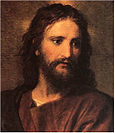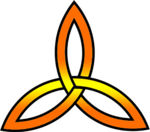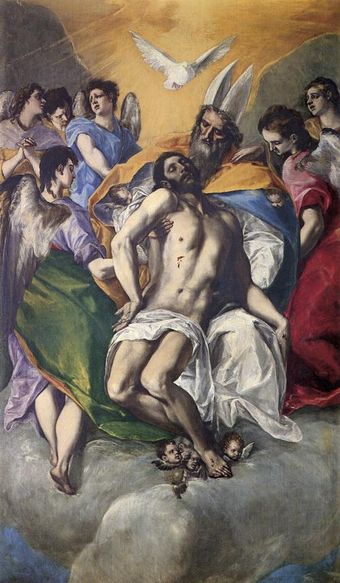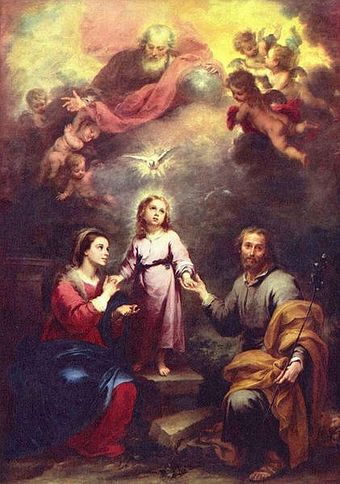Trinity
 From Conservapedia
From Conservapedia 
| |
| Christianity | |
|
Foundations Bible Christian Theology History and Traditions Important Figures | |
| The Godhead |
|---|

|
| God the Father God the Son God the Holy Spirit |
Although not explicit in the Bible,[1] the concept of the Trinity is embraced by the Roman Catholic Church, the Orthodox Church, and nearly all Protestant denominations, but denied by all Unitarians and "Oneness Pentecostals" (such as the United Pentecostal Church). The name was coined by the Church Father Tertullian (A.D. 145-220). It is based on inferences from texts emphasizing the closeness of God-the-Father and Jesus (such as Rom. 8:31-34), the role of the Holy Ghost, and especially the baptismal formula in Matt. 28:19
- Go ye therefore, and teach all nations, baptizing them in the name of the Father, and of the Son, and of the Holy Ghost.[2]
This doctrine is Trinitarian and is called Trinitarianism. Christians who believe the Trinitarian Christian doctrine of the Trinity are called Trinitarians, those who believe in Trinitarianism.
St. Augustine said: "O Lord God, we firmly believe that You are a Trinity. For Truth (Jesus) would never have said, Be Baptized in the Name of the Father and of the Son and of the Holy Ghost, unless You were a Trinity. Nor would He have commanded us to be baptized into One Who was not Lord God."
The Book of Genesis also contains a wonderful Theophany of the Three Divine Persons appearing to men in visible forms, that of the Three Persons in Genesis 18. It is said the Lord God appeared to Abraham, then that he perceived The Three Persons of the Holy Trinity as Three Men. Finally, that he adored Them And yet spoke to Three Persons as to One Lord God, and thus the Holy Bible here clearly demonstrates that the Holy Trinity is One Lord God.
Gen 18:1 "And the LORD appeared unto him in the plains of Mamre: and he sat in the tent door in the heat of the day; 2 And he lift up his eyes and looked, and, lo, three men stood by him: and when he saw them, he ran to meet them from the tent door, and bowed himself toward the ground,3 And said, My LORD, if now I have found favour in thy sight, pass not away, I pray thee, from thy servant:"
In the Eastern Liturgies, it is commonly taken for granted that this was a Theophany (a visible manifestation of the invisible God). For e.g "God in Three Persons appeared to Abraham at the oak of Mambre, and through mercy he was given as reward for his hospitality Isaac. That God we now glorify him as God of our Fathers."[3][4]
St. Augustine comments: "But since three men appeared, and no one of them is said to be greater than the rest either in form, or age, or power, why should we not here understand, as visibly intimated by the visible creature, the equality of the Trinity, and one and the same substance in three persons?"[5]
Contents
- 1 Illustrations and analogies
- 2 Filioque controversy
- 3 The Law of Contradiction and Confusion of person and being
- 4 Denials
- 5 Trinity Sunday
- 6 See also
- 7 References
- 8 External links
- 9 Classic art
Illustrations and analogies[edit]
A good illustration is H2O, one atom of hydrogen and two atoms of oxygen. Remove any one of these three atoms from the molecule and it is no longer water.
Water can also take three forms: solid ice, liquid water, and floating clouds, steam, formless fog and invisible vapor, all of which are considered water. However, this analogy was historically taken too far as applied to God. The denial of the doctrine of the Trinity, as being in essence one Person only, not three divine Persons of One Being, was condemned as Monarchianism and as Modalism and as the heresy of Sabellianism[6] Water is not simultaneously and always solid ice, liquid water, and vapor in every part and particle.
An excellent mathematical illustration of the unity of the Trinity is the geometrical form of the triangular three-sided tetrahedron, a pyramidal construct of a single, indivisible point extending into three equilateral triangular faces simultaneously united to a single triangular base.[7] This is especially evident when an equilateral tetrahedron is made of flawless transparent crystal. Through any one face of the crystal form each of the other sides is clearly visible. Each of the faces is a distinctly different face (they cannot be the same face) but all of them have exactly the same shape, the same size, and the same substance. What is predicated of any one of them is predicated of each of them. A tetrahedral crystal displayed standing on the flat surface of the jeweler's counter or the shelf of a display case cannot exist without three faces inseparably existing as extending from the single, undivided point of one apex to the same undivided triangular base at its surface or foundation on which it stands: a single crystal, not three, with three faces, not one. No matter how it is turned or rotated, it always looks the same and remains the same.
And just as a tetrahedron has a stable vertical configuration because of its triangular base, likewise, any large object, or sturdy, movable, stationary, horizontal supportive platform, which stands firmly on uneven, basically level ground, with an equilateral triangular base of three equidistant points of contact, legs or feet (where a square base of four equidistant points of contact with uneven ground can wobble or tilt), having a measurable height not more than its width, and an upper structure or surface not extending its outward edges beyond bounds more broad or extensive than its base, has the most stable physical configuration, with a stable center of gravity, and the most reliable safety for those on such a platform, who depend on its help to stand securely without any danger of falling.
Also, for any solid physical object to exist, it must have
- a. position / location
b. size / shape
and c. matter / mass.
Its color includes the hue of its color, the intensity or purity of its color, and the degree of the brightness of its color (reflected, generated, or potential only, being absent in darkness without any light, but truly existing, and only becoming an evident fact in the presence of light).
The sun, for example, has size, shape, and luminosity. No one of these facts about the single object of the sun is the same as any one of the other two: size is not luminosity or shape; shape is not size or luminosity; luminosity is not size or shape; yet without these three realities there is no sun.
To be understood, a thing, or even a mental concept, requires knowledge of
- what it is
how it works
and what it does.
A universal concept involves
- a. its meaning or coherence, its correspondence to truth
b. its purpose or reason for being, its "why"
and c. its significance or importance to existent reality, the degree of its impact in or on the universe and the world of mankind.
Another excellent non-physical illustration is the mind, which has three distinct powers of memory, understanding and will, which are not the same thing but are the essential expressions of one mind.[8]
A good three-fold human analogy is
—someone who is inwardly a healthy and intelligent individual, good, honest and truthful, and is personally aware of it with conscious self-knowledge
—someone who is outwardly modest and decent in dress, speech and actions, always kindly, generous, willing to help, and skillful in defending truth and right with wisdom, expressing good character
—someone who with good reason is spiritually delighted and humbly pleased with both the reasonable self-knowledge of true personal goodness and the personally reassuring, consistent, successfully genuine self-expression of goodness in being an actual benefit to everyone else in the whole community.
—We have the inner being, the outer expression, and a richly personal self-delight in both, as one well-balanced healthy individual.
In the same way, God exists as the three distinct but united whole persons of one divine being, utterly unique.[9] God is the Uncreated Holy Good,[10] the Perfect, All-powerful, Eternal One, fully Self-expressing and Self-expressed with Loving Self-knowledge, totally Complete, limitlessly expressing the limitless expression of limitless self-giving loving Being. "God is love" 1 John 4:8b.
Filioque controversy[edit]
One of the causes of the Great East-West Schism of 1054 between the Catholic orthodox Church and the Orthodox catholic Church was the addition of the filioque clause "and the Son" to the Nicene Creed. This clause asserts that the Holy Spirit proceeds "from the Father and the Son".
The Law of Contradiction and Confusion of person and being[edit]
The law of contradiction states that a thing cannot both BE and NOT-BE at the same time. A statement cannot be both true and false at one and the same time.
Trinitarian doctrine does not claim that three Persons are one Person and that one Person is three Persons, or that three Beings are one Being and one Being is three Beings. That would be an absolute contradiction, and impossible. Instead, the doctrine of the Trinity holds that there are three Persons in one Being and one Being in three Persons.
Trinitarian apologists point out that confusion arises when "person" is taken to strictly mean "being" and personality is equated with nature. It is rooted in the common perception that a human being is a person, and on this basis concludes that therefore one person is one being and "being" means "person". This is entirely within the realm of ordinary human experience. But God is not a human being, and moreover, God is absolutely unique. The Trinitarian God is one being of three Persons, and is three persons of one Being. This is outside of normal human experience.
Those who are ignorant of the actual teaching of the doctrine of the Holy Trinity and falsely represent it as an absolute contradiction which violates intelligent reason are only employing a straw man fallacy. The logical fallacy of philosophical skepticism also holds that anything outside of one's own personal experience and understanding is most probably not true and therefore not worthy of belief without the direct proof of personal experience. Another logical fallacy holds that anything that cannot be (eventually) explained and understood according to the laws of science is not real. See Philosophical naturalism.
Christian Trinitarians acknowledge that because the Trinity is outside the realm of normal human experience, and is a mystery that cannot be fully grasped and understood, the doctrine therefore appears unacceptable and unbelievable to many people. They point out that while the doctrine is beyond—some of them prefer to say "above"—human reason and human intelligence, it is not necessarily therefore absolutely against human reason and human intelligence. And there is also the fact that there are many things within ordinary human experience that are not fully understood but are realities of normal human existence. Gravity and magnetism are primary examples. There are also those established paradoxes in science, philosophy and mathematics which defy logical analysis, but are real and not imaginary. Apologists advert to these admitted scientific facts as an aid in their argument of asserting that the Trinity of Persons of the one Being of God is not an impossible or contradictory doctrine but is simply a mystery beyond human understanding.
Denials[edit]
The Arians of the 4th century denied the Trinity. They were condemned as heretics and they died out, but Arian ideas reappeared in Europe after 1500. Isaac Newton was secretly an Arian.
By the mid-18th century Unitarianism had emerged in England, and by 1800 it spread to the U.S.. By 1820 it dominated schools like Harvard University.
In the 20th century Jehovah's Witnesses do not believe in the Trinity, and see it as contradicting the commandment to have no god but the one God.[11] Jehovah Witnesses disparage the Trinity by depicting it as a three-headed creature and claim the doctrine as a corrupt addition by Satan to Christianity. See Great Apostasy.
The doctrine of The Church of Jesus Christ of Latter-Day Saints teaches that God the Father and Jesus as God the Son are two separate physical beings of flesh and bone, and that the Holy Spirit is not a physical Person but a Spirit Personage with influence of guidance and holiness.[12]
- Joseph Smith declared, "I will preach on the plurality of Gods. I have always declared God to be a distinct personage, Jesus Christ a separate and distinct personage from God the Father, and the Holy Ghost as a distinct personage and a Spirit: and these three constitute three distinct personages and three Gods" (Teachings of the Prophet Joseph Smith, p. 370).[13]
Former Mormons have stated that, in the Mormon Temple, the traditional beliefs of orthodox Christians are portrayed as absurd and ridiculous.[14]
The Unitarian and Unitarian Universalist churches have no formulated creed, but they do agree in their denial of the doctrine of the Trinity and their assertion that it has no biblical support. All of the scriptural evidences proposed by Trinitarians in support of the doctrine of the Trinity are rejected as misinterpretations and distortions of the plain meaning of the Bible.
Islam has falsely taught that the Trinity is Father, Son, and Mother (the Virgin Mary), and therefore represents the doctrine as promoting blasphemous idolatry.[15]
Oneness Pentecostals (such as the United Pentecostal Church) also deny the Trinity, and believe that any person baptized "in the name of the Father, the Son, and the Holy Spirit" (which is commonly done in most churches) must be baptized again in "Jesus name only". (The vast majority of those in the Pentecostal and Charismatic movements support the Trinity.) Another false teaching on the Trinity is Modalism, which claims the three Persons are actually manifestations of one Person; this view is believed to be the one held by T.D. Jakes (who refuses to specifically state his views on the Trinity, some argue he does so deliberately so as to pass himself off as orthodox on the Trinity when he is not).
See the following Christian Monarchian articles against Trinitarianism:
- The Trinity Doctrine Is Pagan: The Trinitarian Heresy of the Council of Nicaea", By Pastor G. Reckart, Pastor (jesus-messiah.com)
- The Trinity Doctrine Is Pagan: The Creeds, by G. Reckart, Pastor (jesus-messiah.com)
- —"The Father, Son, and the Holy Spirit are one God in three manifestations. There is one God and one Spirit and this God and this Spirit as to time and eternity is Father in creation, Son in redemption, and Holy Spirit in regeneration." ...
- —"No one can accept the trinity without becoming at that very instant a Catholic. The creeds state this, and those who use the Creeds to substanitiate their doctrine of the trinity proves they are Catholics." —G. Reckart (jesus-messiah.com)
Compare: Monarchianism; Modalism; Unitarianism.
- What is Dynamic Monarchianism? (gotquestions.org)
- Sabellianism (orthodoxwiki.org)
- Monarchianism (orthodoxwiki.org)
- Monarchianism, Matt Slick - CARM Christian Apologetics & Research Ministry (carm.org)
- Monarchians - Catholic Encyclopedia (newadvent.org) Dynamists, Adoptionists, Modalists
- Monarchianism - New World Encyclopedia (newworldencyclopedia.org)
- Heresies: Then and Now, Jason Barker (watchman.org) Offers scriptural refutations
Those denominations, churches and groups that refused to accept the Trinitarian doctrine as formally defined at the Council of Chalcedon are called non-Chalcedonian. They are represented today by several churches and sects.
- Ecclesiarchs - Non-Chalcedonian Churches (my.raex.com)
Read John 14:10-23 (KJV); 15:26; and 16:7-15 (KJV).
Genesis 1:26; 11:7; Isaiah 48:16-17; 61:1; Matthew 3:16-17; 28:19; Luke 1:35; 3:21-22; Acts 10:38; Romans 8:9, 8:11; 15:30; 1 Corinthians 12:4-6; 2 Corinthians 1:21-22; 13:14; Galatians 4:6; Ephesians 4:4-6; Titus 3:4-6; Hebrews 9:14; 1 Peter 1:2; Jude 20-21; Revelation 3:21-22.
- John 4:24 and 2 Corinthians 3:17
- Isaiah 44:6; 48:12-13
and Hebrews 1:2; John 1:1-3 - Revelation 1:8, 17-18 and 22:12-16.
Trinity Sunday[edit]
The Trinity is remembered in worship in liturgical churches each year on Trinity Sunday, the Sunday after Pentecost. The solemn celebration of The Most Holy Trinity is officially scheduled for the following Sunday dates in the U.S.:[16]
- 2017 June 11
2018 May 27
2019 June 16
2020 June 7
2021 May 30
2022 June 12
2023 June 4
2024 May 26
2025 June 15
2026 May 31
2027 May 23
- 2017 June 11
See also[edit]
- Arianism
- In the midst of a Maelstrom: the Holy Spirit and silence: an essay
- Johannine Comma, a verse in the Book of I John which is not considered in some circles to be part of the original text
- Seven Spirits of God
References[edit]
- ↑ Many Christians teach that the Johannine Comma in I John 5:7 supports the view of the Trinity; however, others believe that the Comma was added by later scribes.
- ↑ The word "name" in this passage is singular. The plural word "names" is not said. Semitic peoples understood the name of something or someone was not merely a label, a sound, but an expression of the very nature of the subject as the referent. God is Trinity, but God's nature is unity, having one name, one nature.
- ↑ Octoechos, Sunday, Tone 3, Midnight Office, Ode 7.
- ↑ https://www.academia.edu/13190369/The_Early_Christian_Reception_of_Genesis_18_From_Theophany_to_Trinitarian_Symbolism
- ↑ http://www.newadvent.org/fathers/130102.htm
- ↑ Sabellianism (orthodoxwiki.org)
- ↑ tetrahedron (mathsisfun.com)
- ↑ We can remember something we do not understand; we can understand something new which is not something we remember; and we can will to do something which does not need to be understood, which we have never done before.
- ↑ "unique" means the only one, one-of-a-kind. See Isaiah 45:21 and Isaiah 45:22
- ↑ The word "good" was originally the Old English and Middle English word "God".
- The Origin of the English Word for God. Part One. By Craig Bluemal (bibleanswerstand.org)
- Etymology of the Name God (wahiduddin.net)
- ↑ Watchtower, July 2008
- ↑ The Church of Jesus Christ of Latter-day Saints General Conference, April 1974. The Holy Ghost, Marion G. Romney [1]
- ↑ Teachings of the Prophet Joseph Smith, compiled by Joseph Fielding Smith, 1977, Desert Book Co. ISBN 978-0877476269
- ↑ Mormonism: Christian or Cult? —"The endowment ceremony mocked all doctrines held to by Biblical Christianity." (9. Temple Rituals.) (rapidnet.com)
- ↑ Islam Under Scrutiny by Ex-Muslims: How can Allah have a son when He has no wife? by Mumin Salih (islam-watch.org)
- ↑ Trinity Sunday Future Dates (researchmaniacs.com)
External links[edit]
- 100 Bible verses about Trinity (openbible.info)
- Did Constantine Invent the Trinity? The Doctrine of the Trinity in the writings of the Early Church Fathers, Nathan Busewitz (tms.edu) pdf
- Doctrine of the Trinity (aliveandpowerful.com) pdf an outline
- OrthodoxWiki article: Filioque
- Catholic encyclopedia - Filioque.
- A Brief Declaration and Vindication of the Doctrine of the Trinity, by John Owen (ntslibrary.com) pdf
- The Trinitarian Doctrine of Jonathan Edwards: An Investigation of Charges Against its Orthodoxy, Richard M. Weber (etsjets.org) pdf
- What Is the Doctrine of the Trinity? article by Matt Perman (desiringgod.org) pdf
- Understanding the Biblical Doctrine of the Trinity (Godhead), By Cooper P. Abrams III (bible-truth.org) pdf
- The Doctrine of the Trinity (A Brief Overview), by Kermit Zorley (21stcr.org) pdf
- Reflections on the Doctrine of the Trinity, Raoul Dederen (adventistbiblicalresearch.org) pdf
- The Doctrine of the Trinity (tobelikehim.com) pdf
- The Trinity: Compiled and illustrated by Lionel Hartley PhD (ntslibrary.com) pdf
- Trinity, doctrine of the (archive.org)
- Slovan, Gerald S. The Three Persons in One God (1964) online edition (questia.com)
- Catholic
- The Blessed Trinity (newadvent.org)
- Orthodox
- Orthodox Church in America - The Doctrine of the Holy Trinity (oca.org)
- United Church of Christ
- The Surprising Origins of the Trinity Doctrine, by United Church of Christ (2011) supports rejection of the Trinitarian doctrine as being firmly rooted in paganism—"the true Church was largely absent from the scene, having been driven underground" (the true Church is then identified with heretics, and the orthodox leaders are identified as false teachers of corrupted doctrines.)
- The Council of Nicea and the Doctrine of the Trinity, Written by Don Closson (probe.org) answers by a Christian apologist and historian to all the points of objection raised against Trinitarian doctrine (a perfect counterpoint to the UCC article above)
- Unitarian
- The Unitarian Church - A Study Outline: Salvation by Character, By Braxton Greathouse (1992) (biblebelievers.com) history and beliefs, Unitarian reasons for rejecting the doctrine of the Trinity
- Stanford Encyclopedia of Philosophy. Unitarianism (plato.stanford.edu)
- Unitarians: What are some reasons (or arguments) why you reject the doctrine of the Trinity? What are for you the best objections to the doctrine of the Trinity? (reddit.com)
- The Trinity Delusion: Why I abandoned the Trinity, by Brother Kel, servant of Jesus (angelfire.com) written by a former Lutheran
- Trinitarian Apologetics
- Unitarianism: The Close-Minded & Intolerant Religion, Paul Derengowski, ThM
- CARM Christian Apologetics & Research Ministry. Trinity Chart, by Matt Slick (carm.org)
- Apologetics Index. The Doctrine of the Trinity (apologeticsindex.org)
- Apologetics.com The Doctrine of Trinity (apologetics.com) the reasonableness of the mystery of God—"it is beyond reason, but it is not against reason."
Classic art[edit]



Categories: [Christian Theology]
↧ Download as ZWI file | Last modified: 03/02/2023 09:50:53 | 69 views
☰ Source: https://www.conservapedia.com/Trinity | License: CC BY-SA 3.0
 ZWI signed:
ZWI signed: KSF
KSF